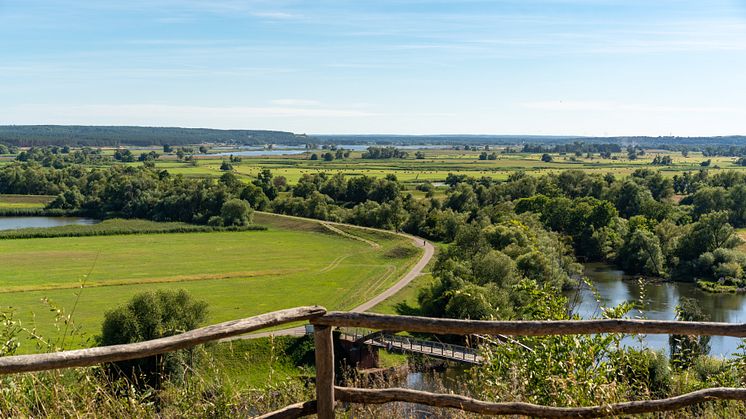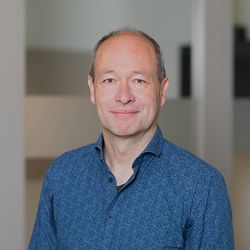
Pressemitteilung -
Oderbruch European Cultural Heritage Site
MEDIA INFORMATION
March 2023
Oderbruch European Cultural Heritage Site
What you can see and do in Eastern Brandenburg
The Oderbruch region is located at the far eastern edge of Brandenburg, very close to neighbouring Poland, about an hour and a half away from Berlin. Peaceful meadows, furrowed by ditches, shape the landscape. In between them there are a few low bushes and fields as far as the eye can see. This diverse region on the River Oder, which forms the border between Germany and Poland, and the Lower Oder Valley National Park are best explored by bike, on foot or by canoe.
The Oderbruch is the first cultural landscape in Europe to be awarded the European Cultural Heritage Label. The title was officially awarded in 2022 in Brussels. Qualified to receive it are sites that exemplify European unification, as well as the ideals and history of Europe.
From Beauregard via Neureetz to Vevais
The Oderbruch was created in the 18th century by the first settlers to Brandenburg, who came from many different parts of Europe. With their first-class engineering expertise they developed a drainage system that still works today. For this massive landscape intervention, King Frederick II had mobilised all his forces and with them created the foundation for the largest populated river polder in Europe. After the land had been drained in 1753 to form the Oderbruch, settlers from all over Europe flooded into the area and established a new and diverse living and economic environment.
For the settlers, small new villages, each with just one street, were built. These can still be identified today on account of their names, many of which begin with “Neu” (New), for example Neureetz or Neuküstrinchen. Others have French names, such as Beauregard, Vevais or Croustillier, which can be attributed to the fact that many of the first settlers were recruited from French-speaking countries.
Cycling, walking and canoeing tours
The first village to be built for the settlers was Neuglietzegöricke, which now belongs to the district of Neulewin and has been placed entirely under a preservation order. In the centre of the attractive village – right next to the church – there is the “Kolonisten-Kaffee” in the old village store, which is definitely worth a visit (Neulietzegöricke – ältestes Kolonistendorf im Oderbruch). A good way to get there is by bicycle, for example on the tour which visits those places in the Oderbruch that have a Fontane connection. To find out more, visit www.reiseland-brandenburg.de/erlebnisberichte/seenland-oder-spree/auf-den-spuren-von-fontane-im-oderbruch.
Alternatively, the cycle route “in the footsteps of Old Fritz” runs through several settlers´ villages such as Letschin and Altlewin: Auf den Spuren des Alten Fritz - Entdeckertour
Anyone looking to immerse themselves in the seclusion of the landscape should choose the cycle tour “Oderbruch – vom Berg ins Tal”. There are large paddocks to see and scattered farmsteads, from where the occasional bleating of sheep can be heard.
Further information at Oderbruch – Vom Berg ins Tal
New Cycle Path to Poland
For railway enthusiasts there is a cycle tour on the old Oderbruch Railway Line. For more than half a century, the railway was what you might call the lifeline of the region. There were more than 40 stations on the 111-kilometre-long Oderbruch Line. It connected the small and large towns and villages in the Oderbruch and at the same time provided access to the Berlin metropole. Nowadays the Oderbruch cycle path runs through the peaceful countryside of the Oderbruch. For further information: Oderbruchbahn-RadwegThe railway line used to cross over the River Oder and into what is now Poland. The tracks have long since been removed, but the bridge over the river is still there and has been turned into a cycle path, thereby connecting the cycle network on the German side to the one on the Polish side. Work on the German side of the modified Europe Bridge between Neurüdnitz in Germany and Siekerki in Poland was completed in June 2022. The bridge can now be used to explore the cycle network on the Polish side.
Taking the peaks by storm in the Oderbruch
Alpine walking at an altitude of almost a thousand metres, four lookout towers and the only “Watzmann” outside Bavaria – there is all of this at the edge of the Oderbruch. On the hilly Upper Barmin Plateau, which is dissected by ravines, hikers should be prepared for a challenge on the stretch between Falkenberg and Bad Freienwalde.
For further information: Mekka für Gipfelstürmer
Alternatively, the Oderbruch can be explored from the water – on the Alte Oder. “From Wriezen to Oderberg on the northern section of the Alte Oder River” is the name of the tour. Gnarled trees and extensive reed beds dominate the landscape, which is home to numerous plants and animals. Bad Freienwalde and Oderberg are two attractive towns to visit on the way. For further information visit Von Wriezen nach Oderberg auf der Alten Oder.
A further cultural highlight in the Oderbruch can be found in the village of Zollbrücke. The “Theater am Rand“ is a very special venue. Performers and owners of the theatre are the accordionist Tobias Morgenstern and actor Thomas Rühmann, well-known for his role in the ARD television series “In aller Freundschaft”. Further Info: https://theateramrand.de/
The Oderbruch has even more culture to offer visitors at the film museum “Kinder von Golzow”. A series of documentaries of the same name, started during the GDR period, portrays the lives of 18 boys and girls from 1961 beyond reunification to 2005, when the last instalment was shown. www.kinder-von-golzow.com
The Oderbruch Museum in Altranft tells the story of the unique drainage system, the people and the rural culture of the region. The exhibitions in the historic building of a Brandenburg manor farming village primarily give a voice to the local people, who talk about their rural crafts, the transformation of their village and the changes in farming methods. www.oderbruchmuseum.de
The Oderbruch stretches for miles in front of the town of Seelow, which is located on a range of hills. Anyone passing through the town on their way to Küstrin, cannot fail to notice the giant memorial to a Soviet soldier which is more than four metres high. It was erected immediately after the victory over Nazi Germany, and, together with the neighbouring Soviet military cemetery, belongs to the Seelow Heights Memorial Centre. The centre serves as a reminder that the history of the Oderbruch was shaped not only by its cultivation during the reign of Frederick II, but also by the fact that in spring 1945, one of the last major battles of the Second World War was fought here. For further information visit www.seelowerhoehen.de
If you would like to stay overnight in the Oderbruch and, for a change, are looking for somewhere unconventional and without 5 star luxury, then the Erlenhof in Kienitz is just right for you. Guest accommodation is in six sheep wagons (www.erlenhof-im-oderbruch.de). A treat for railway enthusiasts is to sleep in an old railway carriage from the Oderbruch Railway. These are located on the banks of the Oder and have a fabulous view of the river.
Germany`s only floodplain national park
The Lower Oder Valley National Park is at the northern end of the Oderbruch. It is Brandenburg´s only national park and the only one in Germany that protects a river floodplain. It stretches for more than 60 kilometres between the village of Hohensaaten in the south and the city of Stettin (Szczecin) in the north, and is the first large-scale conservation area to interlink Germany and Poland. This national park is characterised by its diverse and constantly changing structures – including flood areas, alluvial forests, the branches of the Alte Oder, sandbanks and wetlands. These make the area one of the most species-rich habitats in Europe. In spring and autumn, for example, the Lower Oder Valley National Park is the setting for the great bird migration, an unforgettable natural spectacle. With their legendary trumpeting calls, thousands of cranes fly to their resting places to prepare for the long flight south. During the day the birds are best observed at their feeding places. Their evening flight into the waters of the national park, where they roost, is particularly impressive. Besides cranes, thousands of greylag geeseand whooper swans also land here to rest on their journey south.
Those who want to venture into the heart of the national park on foot can start out in Criewen near Schwedt (Oder) in the Uckermark on the ten kilometre-long “Weg der Auenblicke” path. Parts of it involve walking on boardwalks and charmingly unspoilt forest trails. Especially in the autumn, several bird species can be observed flying around to the left and right of the path – everything from cranes to greater white-fronted and bean geese or widgeons and tufted ducks. Back in Criewen, the Lenné Park and the national park visitor centre are definitely worth a visit.
Getting to the Oderbruch by bus and train
Getting to the Oderbruch by bus and train is easy and comfortable. It also makes it possible to begin a cycling or walking tour at one location and to end it at another. From Berlin take either the RE3 regional express train to Eberswalde or the RE1 to Frankfurt (Oder). Then change onto the RB60 regional train, which runs through the Oderbruch and connects those two cities. In the Oderbruch, the number 879 bus is ideal for days out. It stops at Bad Freienwalde and Wriezen and is scheduled to connect with trains to and from the region. For further information: Oderbus Ausflugslinie 879
Further Information:
www.reiseland-brandenburg.de
Themen
Kategorien
Regionen
Die TMBTourismus-Marketing Brandenburg GmbH wurde 1998 gegründet. Als Destination-Management-Organisationist die TMB für die langfristige und nachhaltige Positionierung sowieEntwicklung und Vermarktung der touristischen Angebote im Land Brandenburgverantwortlich. Hierzu zählt insbesondere die Markenführung der touristischenMarke Brandenburg und der damit verbundene Markenprozess. Die Gesellschafterder TMB sind das Land Brandenburg (59 Prozent), die VereinigungBrandenburgischer Körperschaften zur Förderung der BrandenburgischenTourismuswirtschaft GbR (36 Prozent) und die Berlin Tourismus & KongressGmbH (visitBerlin) (5 Prozent).
TMB Tourismus-Marketing Brandenburg GmbH, Babelsberger Straße 26, 14473 Potsdam
Telefon: +49 (0)331 29873-0 | Telefax: +49 (0)331 29873-73
service@reiseland-brandenburg.de | www.reiseland-brandenburg.de
Amtsgericht Potsdam HRB 11403 | Ust-IdNr. DE194533636Vorsitzender des Aufsichtsrates: Staatssekretär Hendrik Fischer | Geschäftsführer: Dieter Hütte




